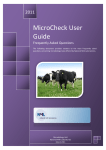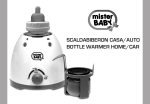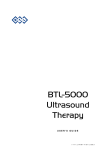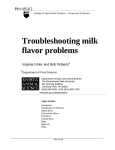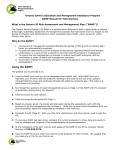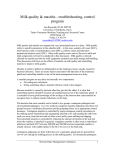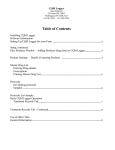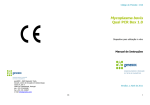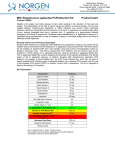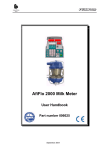Download MicroCheck User Guide - National Milk Laboratories
Transcript
2011 MicroCheck User Guide Frequently Asked Questions The following document provides answers to the most frequently asked questions concerning microbiology tests offered by National Milk Laboratories. Microbiology Unit National Milk Laboratories March 2011 Page |2 MicroCheck User Guide 2011 Page |3 MicroCheck User Guide 2011 Contents Customer Services Contact Details ......................................................................................................... 4 Introduction ............................................................................................................................................ 5 MicroCheck products ...................................................................................................................... 5 Test methods .......................................................................................................................................... 5 What is qPCR testing? ..................................................................................................................... 5 How does qPCR compare to bacterial culture for pathogen identification? .................................. 6 What is a somatic cell count? ......................................................................................................... 6 Why do I have a negative result for all the bacteria but a high somatic cell count? ...................... 6 Why don’t I have a SCC reading? .................................................................................................... 6 Why does it say “Insufficient Sample Size”? ................................................................................... 7 I have always used bacterial culture, do you still offer this? .......................................................... 7 Test Types ............................................................................................................................................... 7 What is the difference between a Bacto Breakdown and a Mastitis ID? ....................................... 7 What are the costs for testing (veterinary pricelists are available)? .............................................. 8 Do you offer antibiotic sensitivity on the bacterial targets identified? .......................................... 8 Sample Condition .................................................................................................................................... 8 How can samples be sent in? .......................................................................................................... 8 Results ..................................................................................................................................................... 8 In what form can I receive my results? ........................................................................................... 8 Why did I not receive my qPCR results the same day the sample was received? .......................... 8 I have ordered a Bacto Breakdown, but I have only received one report, why? ........................... 9 How do I obtain my Herd Companion username and password? .................................................. 9 Can my vet access my results on Herd Companion? ...................................................................... 9 How do I know when results have arrived? .................................................................................... 9 Interpretation ......................................................................................................................................... 9 qPCR .................................................................................................................................................... 9 What do I do about this particular pathogen? ............................................................................... 9 Can I still have a qPCR test if the cow is being treated with antibiotics? ....................................... 9 Plant Hygiene .................................................................................................................................... 10 The number of bacteria for Thermodurics, Psychrotrophs and Coliforms doesn’t add up to the Total Viable Count (TVC), why not? .............................................................................................. 10 Why do I have a high Coliform/ Thermoduric/ Psychrotroph/ TVC? What do I do? .................... 10 Appendix 1 – Online reporting .............................................................................................................. 11 Page |4 MicroCheck User Guide 2011 How do I access results online? .................................................................................................... 11 Appendix 2 – Individual Cow Mastitis ID guidance notes ..................................................................... 12 Appendix 3 – Bulk Milk Mastitis ID guidance notes .............................................................................. 12 Appendix 4 – Bacto Breakdown guidance notes .................................................................................. 12 Customer Services Contact Details Customer Services on 0844 7255567 [email protected] Page |5 MicroCheck User Guide 2011 Introduction MicroCheck products NML is committed to supplying a high quality and efficient testing service for its clients. Milk buyers, farmers and vets have been routinely using NMLs MicroCheck services since 2004. NMLs services include milk quality testing, antibiotic contaminant testing, traditional microbiology and modern molecular biology. NML have worked hard to ensure that customers can obtain results with ease in a timely manner. This guide is intended to provide answers to common questions regarding NMLs Microbiology services. These services include: qPCR Basic somatic cell counts (SCC) Culture testing Each of these will be addressed in turn. It is important to note that SCCs are included within the Bacto Breakdown and Mastitis ID test suites. Test methods What is qPCR testing? Quantitative Polymerase Chain Reaction (qPCR) is a molecular biological method for amplifying a specific DNA sequence within a sample. The reaction involves a DNA-binding fluorescent dye and requires a cyclical heating and cooling program. As specific DNA is formed, the fluorescence (proportional to the amount of DNA accumulating) is measured after each heat/cool cycle. If more DNA was present at the start, it takes a lower number of cycles for the amount of DNA to cross a threshold (Ct value). This method shows whether DNA from a pathogen was present and by how much. Page |6 MicroCheck User Guide 2011 How does qPCR compare to bacterial culture for pathogen identification? Both qPCR and culture are useful for mastitic pathogen detection and both have relative ‘pros and cons’. The main advantage to qPCR is the ability to use bronopol preserved milk to prevent growth in transit and to enable room temperature transport. It is important to remember that DNA from both live and dead cells will be detected by qPCR whereas culture would only produce results for viable cells. If culture is used and no growths occur (in over 20% of cases), it can be useful to qPCR test the sample to see if pathogens can be detected. Furthermore, whilst qPCR does not detect as many potential mastitic pathogens as culture methods, qPCR is able to detect pathogens responsible for over 95% of the UKs mastitis-causing pathogens. Culture methods are still useful for further investigation or further confirmatory testing especially in cases where Bacillus, yeasts, Pseudomonas or fungi are suspected. What is a somatic cell count? Somatic cells are ‘bacteria-fighting’ cells or white blood cells that move to an infection site e.g. udder, and minimize the infection. It can be indicative of sub-clinical mastitis i.e. where cows exhibit no outward signs of mastitis. SCC is important for identifying the problem in the first instance to indicate that a mastitis ID needs to be performed, and so then the specific bug (bacteria) can be identified. The test can be carried out on both bulk milk samples and individual cow samples. Kits are available and preservative can be used if no culture testing is required. Why do I have a negative result for all the bacteria but a high somatic cell count? Test Suite Reason Bacto Breakdown Plant Hygiene (bacteriology) Has the sample been frozen? If so, the pathogens may have been killed and are no longer viable for our culture methods. Freezing can cause cell lysis and prevent growth for some species. Mastitis ID The cause may be a rare mastitic pathogen like algal sp., Yeast sp. or Bacillus sp. These are not identified by the NML test. If clinical mastitis cases occur and milk is discarded, you will not identify potential causes for the clinical infection from bulk milk samples. Why don’t I have a SCC reading? If it states “Sour Milk Unreadable” for a mastitis sample then either the milk was already clotted upon leaving the cow or the preservative pill was not mixed thoroughly enough in the sample to prevent souring. If there are lumps in the milk it cannot pass through the fine tubing to obtain a somatic cell count reading. If there is high bacterial content the milk may sour more rapidly regardless of the storage temperature. Psychrotrophs can grow at refrigeration temperatures and therefore if present can still cause the milk to sour. There have been examples of milk that has reached NML within 24 hours of sampling that has still been sour. For mastitis ID testing, always use the preservative provided. MicroCheck User Guide Page |7 2011 Why does it say “Insufficient Sample Size”? Insufficient sample size means that there was not enough milk provided or that the storage sample was also used for a variety of other tests. Payment tests for the milk buyers will take priority over any other tests, including MicroCheck. I have always used bacterial culture, do you still offer this? Yes we do, to an extent. Within our Bacto Breakdown service we culture for total viable counts (all live bacteria within the sample), Psychrotrophs (bacteria that can grow at refrigerated temperatures), Coliforms (indicative of faecal contamination) and Thermodurics (bacteria that can withstand pasteurization at 63.5 0C). Test Types What is the difference between a Bacto Breakdown and a Mastitis ID? Bacto Breakdowns utilise traditional bacteriology in addition to qPCR. They are performed on bulk tank samples and provide information concerning Plant (farm) hygiene and also provide an indication of what mastitic pathogen DNA is present at the herd level. Mastitis ID can either be performed on a bulk tank sample or be performed on individual cow samples. Remember that milk from clinical cases is usually discarded and thus bulk tank qPCR will not identify specific clinical causes in these cases. It is simply the identification of pathogens through qPCR. The following table details the tests included within each test suite: Individual Test Total Viable Count (TVC) is a measure of all bacteria that is “alive” in the milk sample Coliforms are indicative of faecal (environmental contamination) Thermodurics are bacteria that can withstand pasteurization at 63.5C Psychrotrophs are bacteria that are able to grow at refrigerated temperatures Mastitis ID for 11 key mastitis causing pathogens along with Staphylococcus spp penicillin resistance using qPCR Bacto Breakdown √ Mastitis ID Parlour Hygiene √ √ √ √ √ √ √ √ √ Page |8 MicroCheck User Guide 2011 What are the costs for testing (veterinary pricelists are available)? Test Suite Price Ad-hoc Bacto Breakdown (Bulk only) £45 + VAT per sample Quarterly Surveillance Bacto Breakdown (4 per £150 + VAT per year year tested automatically using NML sample) 1-5 Mastitis IDs ordered in one go £17.50 + VAT per sample >5 Mastitis IDs ordered in one go £15 + VAT per sample Parlour Hygiene Suite (Bulk only) £20 + VAT per sample Do you offer antibiotic sensitivity on the bacterial targets identified? We do not offer antibiotic sensitivity testing; however we do identify the Staphylococcus penicillinresistant gene, β-lactamase. Sample Condition How can samples be sent in? Test Suite Bacto Breakdown or Parlour Hygiene Mastitis ID Condition For ‘7-day collected’ customers, NML-stored payment backup samples can be used. For non-7-day clients, please contact your milk buyer regarding collection of an additional sample. Fresh, frozen or bronopol preserved. Ensure preservative is mixed thoroughly and if the sample already has clots a SCC result will not be obtained. Results In what form can I receive my results? Post Fax Email Herd Companion website - Micro Monitor (Passwords are available from NMR) Why did I not receive my qPCR results the same day the sample was received? It is stated that we aim to return results the same day, but this is not a guaranteed service for the following reasons: DNA is extracted from the samples the same day, but only so many samples can fit into the machine, therefore samples received first are tested first. The sample may have an Internal Amplification Control (IAC) failure. IAC failures are caused by large quantities of bacterial DNA competing and inhibiting the reaction. The test is repeated with diluted DNA and the result calculated to account for the dilution used. Page |9 MicroCheck User Guide 2011 I have ordered a Bacto Breakdown, but I have only received one report, why? Bacto Breakdowns generate 2 reports: qPCR report sent as soon as the testing is completed, usually within 24 hours Plant hygiene culture report within 5 working days How do I obtain my Herd Companion username and password? As an NMR/NML customer, you will have an assigned username and password. If you give your details to customer services, they will be able to issue you with your access details. Please note that if the Parlour Hygiene suite is tested alone (not with the Bacto Breakdown suite), results are not yet available via Herd Companion. Can my vet access my results on Herd Companion? If farmers sign an access agreement form, their vet will be able to instantly access health and testing reports. We recommend that farmers ensure their vet is informed of their test results and Herd Companion is a quick and easy way of doing this. How do I know when results have arrived? If we have an email address for the farmer, an automated email will be sent to ensure the farmer (and the vet - see above) is informed that results are available via Herd Companion. Interpretation qPCR What do I do about this particular pathogen? Customers are advised to consult their vet regarding result interpretation. It is important to remember that it isn’t always the most abundant organism that is the cause of the infection. Furthermore, the result is only as good as the sample. If strict aseptic technique is applied to sampling, you can be more confident of the results. Refer to Mastitis ID guidance notes (attached in the appendix). Bulk milk results should not be used as a guide for treating individual cows. Remember that clinically infected milk will not contribute to the bulk tank. Also, consider the timing of infection for individual cows. This could provide an indication as to whether the pathogen is associated with dry period infection or whether it has been picked up during lactation. Consult NMR records in conjunction with your vet. Can I still have a qPCR test if the cow is being treated with antibiotics? Milk from cows being treated with antibiotics can be tested; however the test will not distinguish between living and dead bacteria. This is useful if you wish to determine, which pathogen is present to ensure the correct antibiotic is being used, but it can take at least two weeks before dead bacteria are flushed out. P a g e | 10 MicroCheck User Guide 2011 Plant Hygiene The number of bacteria for Thermodurics, Psychrotrophs and Coliforms doesn’t add up to the Total Viable Count (TVC), why not? The results depend on the spread of the bacteria within the milk as it is shared between the tests. There may also be additional organisms making up the TVC that are not covered by thermodurics, psychrotrophs and coliforms. Why do I have a high Coliform/ Thermoduric/ Psychrotroph/ TVC? What do I do? Refer to the Bacto Breakdown guidance notes (attached in the appendix). National Milk Laboratories can only advise customers to speak to milk hygiene consultants or veterinary practitioners. P a g e | 11 MicroCheck User Guide 2011 Appendix 1 – Online reporting How do I access results online? Both farmers and vets can access all test results via the Herd Companion website (http://www.nmr.co.uk/herd-companion/). When you access the main menu, click on the Micro Monitor (for Microbiology results). Within Micro Monitor you can select the report you wish to view (see figure below). P a g e | 12 MicroCheck User Guide 2011 If you select ‘Mastitis ID suite’, you are given a list of test reports (displayed below). If you click on any of the reports, it will display the test results for that individual animal. An example report is displayed below. P a g e | 13 MicroCheck User Guide 2011 Appendix 2 – Individual Cow Mastitis ID guidance notes qPCR individual cow test result interpretation This test is designed to detect the presence of 11 key mastitis pathogens (responsible for >95% of cases) along with penicillin resistance in Staphylococcus species. Results are reported according to the level of bacteria detected in preserved milk. Bacterial growth in transit does not occur but multiple pathogens can be detected. Result Interpretation – Mastitis Pathogens Result Low Medium High Interpretation NEG Negative/not detected POS Positive in low numbers POS Positive in moderate numbers POS Positive in high numbers Where >90% or >99% of the bacterial load is attributed to one pathogen, this will appear in the report. Pathogens can be split roughly into two groups (though some can fit into both groups): 1) Contagious mastitis pathogens: Staphylococcus aureus, other Staphylococcal species, Corynebacterium bovis, Streptococcus agalactiae & Streptococcus dysgalactiae. Abbreviated hereafter as C. Contagious organisms are well adapted to survival and growth in the mammary gland and frequently cause infections lasting weeks, months or years. The infected gland is the main source of these organisms in a dairy herd and transmission of contagious pathogens to uninfected quarters and cows occurs mainly during milking time via cloths, gloves and teat liners. 2) Environmental mastitis pathogens: Streptococcus uberis, E.coli, Enterococcus species, Serratia marcescens, Arcanobacterium pyogenes, and Klebsiella spp. Abbreviated hereafter as E. The primary source of environmental pathogens is the surroundings in which a cow lives. Sources of environmental pathogens include manure, bedding, feedstuffs, dust, dirt, mud and water. Low levels of some bacteria (e.g. CNS) can be treated with less urgency. However, different pathogens can have different infective doses. It is therefore important to discuss result interpretation with your vet. Presence of Streptococcus agalactiae should be looked at as a matter of priority. Please remember that environmental contamination could occur if poor sampling technique is used. It is important to discuss treatment options with your vet P a g e | 14 MicroCheck User Guide 2011 Guidance Notes Staphylococcus aureus - C - Bacteria are shed from infected quarters in low numbers. Damage to the udder tissue reduces milk yield significantly. It can resist treatment via common antibiotics and thus it is important to use the correct antibiotics for treatment. Culling may be an option for persistent S. aureus cows. Staphylococcus species (Coagulase Negative Staphylococci (CNS)) - C – Subclinical mastitis caused by intramammary infections (IMI) with coagulase-negative staphylococci (CNS) is common in dairy cows and may cause herd problems. Control of CNS mastitis is complicated by the fact that CNS contains a large number of different species and so veterinary advice should be sought. CNS is of low pathogenicity and is unlikely to be the sole cause of infection. The most likely mastitis-causing bacteria should be ruled out before CNS is considered significant in suspected mastitis cases. Streptococcus agalactiae - C - Very high numbers of bacteria are shed and the cell counts can be as high as 10 million without any clinical signs. Herd cell counts also increase considerably with this form of mastitis. Careful attention to pre milking teat preparation teat dipping is essential to minimise transmission of this organism. Treatment success rates are usually good. Streptococcus dysgalactiae - C -is usually associated with teat injury, either chaps or physical damage that may be caused by poor milking machine function. Essential to assess teat condition and consider having the parlour tested. Infections tend to be subclinical. Corynebacterium bovis - C - Sources of C. bovis are infected udders and teat canal. Spread of C. bovis is from cow to cow at milking. Proper pre and post milking teat disinfection may control the spread from cow to cow. Most cases are not clinical. Dry cow therapy may be effective to eliminate C. bovis intramammary infection. Streptococcus uberis – E/C - A common cause of new infection in the dry period, and outbreaks can occur at pasture. It can produce mild to severe mastitis that can be difficult to treat. It can be shed in very high numbers by infected quarters. Sub-clinical infections may occur resulting in high cell count cows. Cow to cow transmission is also likely so good teat preparation and disinfection can be useful to minimise transmission. Escherichia coli (E.coli) - E - Effective control includes general cow and bedding hygiene and to prevent dry cow teat end exposure. Also pre-dipping and drying teats prior to milking may reduce infection during lactation. E.coli can be found as a contaminant if samples are not taken carefully. Enterococcus faecalis and/or faecium - E – These bacteria are found in the gut and are an indicator of faecal contamination. Recommended control procedures include effective milking time hygiene and pre- and post-milking teat disinfection. Also consider dry cow and cubicle bedding hygiene. Klebsiella spp. - E – This is a member of the coliform family, are found in the faeces, in bedding and on wet dirty udders. Can cause transient, peracute or acute mastitis. They often increase in numbers in warm, wet weather. MicroCheck User Guide 2011 P a g e | 15 Serratia marcescens - E - Infection can be sub-clinical or clinical. Cure rates using antibiotic treatment can be variable. Transmission can be minimised by ensuring bedding and teat hygiene. Arcanobacterium pyogenes - E -Sources include wound infections, teat injuries, udder infections, abscesses, and genital tracts. Spread may be due to contact of teats with a contaminated environment. A. pyogenes may be transmitted by flies. Control measures include fly control programs, maintaining cows in clean and dry calving areas, drying up ("killing") affected quarters to reduce the risk of spreading the infection to other cows, and removing the affected cow from the herd. A. pyogenes often cause an acute mastitis. Infections occur most frequently in dry cows or heifers before calving. Penicillin Resistance: Staphylococcal beta-lactamase gene If a positive Staph result is detected (this applies to both Staph aureus and Staph spp. results), a beta-lactamase gene presence may be evident. This may indicate potential problems with penicillin treatment. This is reported as follows: Result Low Medium NEG POS POS POS High Interpretation Susceptible to penicillin; suitable for use in treatment Resistant to penicillin; do not use in treatment Resistant to penicillin; do not use in treatment Resistant to penicillin; do not use in treatment Presence of the Staphylococcal beta-lactamase gene in the sample indicates there is a degree of penicillin resistance in the herd. You should discuss mastitis treatment options with your vet. Next steps Always discuss treatment of individual cows with your vet. If Bacillus or fungi are suspected (in rare cases), consider the use of culture testing (available through your vet). In the case of environmental pathogens, consider reviewing milking hygiene with advice from your vet. Monitor teat condition and discuss treatment with your vet. Ensure milking machine function is optimal. Results available through Micro Monitor on the Herd Companion website (via - www.nmr.co.uk). Please contact customer services for your free username and password. P a g e | 16 MicroCheck User Guide 2011 Appendix 3 – Bulk Milk Mastitis ID guidance notes qPCR bulk milk test result interpretation This test is designed to detect the presence of 11 key mastitis pathogens (responsible for >95% of cases) along with penicillin resistance in Staphylococcus species. Results are reported according to the level of bacteria detected in preserved milk. Bacterial growth in transit does not occur but multiple pathogens can be detected. Result Interpretation – Mastitis Pathogens Result Low Medium High Interpretation NEG Negative/not detected POS Positive in low numbers POS Positive in moderate numbers POS Positive in high numbers Where >90% or >99% of the bacterial load is attributed to one pathogen, this will appear in the report. Pathogens can be split roughly into two groups (though some can fit into both groups): 1) Contagious mastitis pathogens: Staphylococcus aureus, other Staphylococcal species, Corynebacterium bovis, Streptococcus agalactiae & Streptococcus dysgalactiae. Abbreviated hereafter as C. Contagious organisms are well adapted to survival and growth in the mammary gland and frequently cause infections lasting weeks, months or years. The infected gland is the main source of these organisms in a dairy herd and transmission of contagious pathogens to uninfected quarters and cows occurs mainly during milking time via cloths, gloves and teat liners. 2) Environmental mastitis pathogens: Streptococcus uberis, E.coli, Enterococcus species, Serratia marcescens, Arcanobacterium pyogenes, and Klebsiella spp. Abbreviated hereafter as E. The primary source of environmental pathogens is the surroundings in which a cow lives. Sources of environmental pathogens include manure, bedding, feedstuffs, dust, dirt, mud and water. Please note that environmental pathogens in the bulk tank are less likely to have come from inside the udders. Consider whether milking hygiene is satisfactory. S.uberis is the most likely exception to this as cow-adapted strains can be contagious. Presence of Streptococcus agalactiae should be looked at as a matter of priority. Bulk results should not be used as a treatment Guidance Notes guide - speak with your vet P a g e | 17 MicroCheck User Guide 2011 Guidance Notes Staphylococcus aureus - C - Bacteria are shed from infected quarters in variable numbers. Damage to the udder tissue reduces milk yield significantly. It can resist treatment via common antibiotics. Staphylococcus species (Coagulase Negative Staphylococci (CNS)) - C – Subclinical mastitis caused by intramammary infections (IMI) with coagulase-negative staphylococci (CNS) is common in dairy cows and may cause herd problems. Control of CNS mastitis is complicated by the fact that CNS contains a large number of different species and so veterinary advice should be sought. CNS is of low pathogenicity and is unlikely to be the sole cause of infection. The most likely mastitis-causing bacteria should be ruled out before CNS is considered significant in suspected mastitis cases. Streptococcus agalactiae - C - Very high numbers of bacteria are shed and the cell counts can be as high as 10 million without any clinical signs. Herd cell counts also increase considerably with this form of mastitis. Careful attention to pre milking teat preparation teat dipping is essential to minimise transmission of this organism. Treatment success rates are usually good but infected cows should be sought. Streptococcus dysgalactiae - C -is usually associated with teat injury, either chaps or physical damage that may be caused by poor milking machine function. Essential to assess teat condition and consider having the parlour tested. Infections tend to be subclinical so can be monitored via bulk milk. Corynebacterium bovis - C - Sources of C. bovis are infected udders and teat canal. Spread of C. bovis is from cow to cow at milking. Proper pre and post milking teat disinfection may control the spread from cow to cow. Most cases are not clinical. Streptococcus uberis – E/C - A common cause of new infection in the dry period, and outbreaks can occur at pasture. It can produce mild to severe mastitis that can be difficult to treat. It can be shed in very high numbers by infected quarters. Sub-clinical infections may occur resulting in high cell count cows. Cow to cow transmission is also likely so good teat preparation and disinfection can be useful to minimise transmission. S. uberis can be found in bulk tank samples as a contaminant if milking hygiene processes are not maintained. Escherichia coli (E.coli) - E - E. coli rarely causes persistent subclinical mastitis and thus care must be taken when interpreting bulk milk results when E. coli is present. It can be found in bulk tank samples as a contaminant if milking hygiene processes are not maintained. Also pre-dipping and drying teats prior to milking may reduce levels in the bulk tank. Enterococcus faecalis and/or faecium - E – These bacteria are found in the gut and are an indicator of faecal contamination. Recommended control procedures include effective milking time hygiene and pre- and post-milking teat disinfection. Also consider dry cow and cubicle bedding hygiene. Klebsiella spp. - E – This is a member of the coliform family, are found in the faeces, in bedding and on wet dirty udders. If found in bulk milk samples, it is likely that contamination is the cause. MicroCheck User Guide 2011 P a g e | 18 Serratia marcescens - E - Infection can be sub-clinical or clinical. Transmission can be minimised by ensuring bedding and teat hygiene. It is possible that this pathogen could be shed into the bulk milk from sub clinical cows. Arcanobacterium pyogenes - E -Sources include wound infections, teat injuries, udder infections, abscesses, and genital tracts. As A. pyogenes often causes acute mastitis, cases are often clinical resulting in milk withdrawal from the bulk tank, it is therefore unlikely to be found in bulk samples. Penicillin Resistance: Staphylococcal beta-lactamase gene If a positive Staph result is detected (this applies to both Staph aureus and Staph spp. results), a beta-lactamase gene presence may be evident. This may indicate potential problems with penicillin treatment for affected cows. This is reported as follows: Result Low Medium NEG POS POS POS High Interpretation Susceptible to penicillin; suitable for use in treatment Resistant to penicillin; do not use in treatment Resistant to penicillin; do not use in treatment Resistant to penicillin; do not use in treatment Presence of the Staphylococcal beta-lactamase gene indicates there is likely to be some penicillin resistance in the herd. You should discuss mastitis treatment options with your vet. As with all results we recommend you analyse these in conjunction with your veterinarian. Next steps Identify ‘problem’ cows using NMR records and veterinary guidance. Discuss the need for further sampling with your vet. Send samples (kits available from NML) for qPCR testing. Consider whether environmental pathogens are present due to poor hygiene and take relevant steps to improve this. Results available through Micro Monitor on the Herd Companion website (via - www.nmr.co.uk). Please contact customer services for your free username and password. P a g e | 19 MicroCheck User Guide 2011 Appendix 4 – Bacto Breakdown guidance notes P a g e | 20 MicroCheck User Guide 2011 For more information on any of our services please call customer services on 0844 7255567 www.nationalmilklaboratories.co.uk I108 - 200411




















